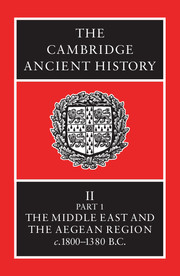Book contents
- Frontmatter
- Contents
- List of Maps
- List of Tables
- List of Text-figures
- Preface
- CHAPTER I NORTHERN MESOPOTAMIA AND SYRIA
- CHAPTER II EGYPT: FROM THE DEATH OF AMMENEMES III TO SEQENENRE II
- CHAPTER III PALESTINE IN THE MIDDLE BRONZE AGE
- CHAPTER IV
- CHAPTER V HAMMURABI AND THE END OF HIS DYNASTY
- CHAPTER VI ANATOLIA c. 1750–1600 B.C.
- CHAPTER VII PERSIA c. 1800–1550 B.C.
- CHAPTER VIII EGYPT: FROM THE EXPULSION OF THE HYKSOS TO AMENOPHIS I
- CHAPTER IX EGYPT: INTERNAL AFFAIRS FROM TUTHMOSIS I TO THE DEATH OF AMENOPHIS III
- CHAPTER X SYRIA c. 1550–1400 B.C.
- CHAPTER XI PALESTINE IN THE TIME OF THE EIGHTEENTH DYNASTY
- CHAPTER XII THE ZENITH OF MINOAN CIVILIZATION
- CHAPTER XIII THE LINEAR SCRIPTS AND THE TABLETS AS HISTORICAL DOCUMENTS
- CHAPTER XIV THE RISE OF MYCENAEAN CIVILIZATION
- CHAPTER XV ANATOLIA c. 1600–1380 b.c.
- CHAPTER XVI THE ARCHAEOLOGICAL EVIDENCE OF THE SECOND MILLENNIUM B.C. ON THE PERSIAN PLATEAU
- BIBLIOGRAPHIES
- Chronological Tables
- Index to Maps
- General Index
- Map 1: Greece and the Aegean Islands in the Middle Bronze Age.
- Map 3: Babylonia and Western Persia.
- Fig. 7. Plan of the Palace at Cnossus.
- Map 6: Ancient Asia Minor and Northern mesopotamia
- References
CHAPTER IX - EGYPT: INTERNAL AFFAIRS FROM TUTHMOSIS I TO THE DEATH OF AMENOPHIS III
Published online by Cambridge University Press: 28 March 2008
- Frontmatter
- Contents
- List of Maps
- List of Tables
- List of Text-figures
- Preface
- CHAPTER I NORTHERN MESOPOTAMIA AND SYRIA
- CHAPTER II EGYPT: FROM THE DEATH OF AMMENEMES III TO SEQENENRE II
- CHAPTER III PALESTINE IN THE MIDDLE BRONZE AGE
- CHAPTER IV
- CHAPTER V HAMMURABI AND THE END OF HIS DYNASTY
- CHAPTER VI ANATOLIA c. 1750–1600 B.C.
- CHAPTER VII PERSIA c. 1800–1550 B.C.
- CHAPTER VIII EGYPT: FROM THE EXPULSION OF THE HYKSOS TO AMENOPHIS I
- CHAPTER IX EGYPT: INTERNAL AFFAIRS FROM TUTHMOSIS I TO THE DEATH OF AMENOPHIS III
- CHAPTER X SYRIA c. 1550–1400 B.C.
- CHAPTER XI PALESTINE IN THE TIME OF THE EIGHTEENTH DYNASTY
- CHAPTER XII THE ZENITH OF MINOAN CIVILIZATION
- CHAPTER XIII THE LINEAR SCRIPTS AND THE TABLETS AS HISTORICAL DOCUMENTS
- CHAPTER XIV THE RISE OF MYCENAEAN CIVILIZATION
- CHAPTER XV ANATOLIA c. 1600–1380 b.c.
- CHAPTER XVI THE ARCHAEOLOGICAL EVIDENCE OF THE SECOND MILLENNIUM B.C. ON THE PERSIAN PLATEAU
- BIBLIOGRAPHIES
- Chronological Tables
- Index to Maps
- General Index
- Map 1: Greece and the Aegean Islands in the Middle Bronze Age.
- Map 3: Babylonia and Western Persia.
- Fig. 7. Plan of the Palace at Cnossus.
- Map 6: Ancient Asia Minor and Northern mesopotamia
- References
Summary
THE RULE OF THE MILITARY KING
Out of the struggles to regain her independence and her ascendancy over the warlike nations of Western Asia, Egypt during the Eighteenth Dynasty emerged, for the first time in her history, as a predominantly military state under the rule of a king dedicated from early youth to the leadership of his army and navy and to the expansion and consolidation of his empire by force of arms.
Elevated while scarcely more than a boy to the rank of commander-in-chief of the armed forces, the heir apparent to the Egyptian throne under Tuthmosis I and his successors devoted a considerable portion of his early years to training himself in the arts of war. Proficiency as an archer, a charioteer, and a ship-handler, achieved under the supervision of his father's veterans, ranked high among the qualifications demanded of the future king and were the accomplishments in which throughout his life he took his greatest pride. Experience in actual combat followed shortly after the young ruler's accession to the throne, an occasion almost invariably seized upon by the princes of Nubia and Asia to revolt against their Egyptian overlord. Following the conquests of Tuthmosis III one or two campaigns usually sufficed to restore order throughout the empire and eliminated the need for further show of force on the part of the pharaoh. Nevertheless, the military point of view remained with the king throughout his reign and profoundly affected the nature of his government and the internal conditions of the land which he governed.
- Type
- Chapter
- Information
- The Cambridge Ancient History , pp. 313 - 416Publisher: Cambridge University PressPrint publication year: 1973
References
- 9
- Cited by



